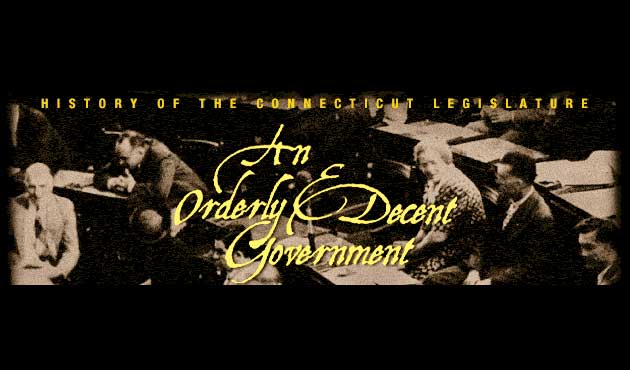Connecticut’s First Legislature
Connecticut’s first legislative body, the General Court, had only one chamber and exercised judicial as well as legislative responsibilities. At its April sessions, a governor and six magistrates were chosen from nominations submitted by the towns. They were joined by four deputies each from the existing towns of Windsor, Wethersfield, and Hartford. Basing legislative representation on the town, rather than the individual, would shape Connecticut’s political affairs for over 300 years.
The Legend of the Charter Oak

Painting of the Charter Oak
Fearing a tightening of royal control, the General Court sent John Winthrop Jr. to England to clarify the colony’s legal status. In 1662, he successfully negotiated an extraordinarily liberal charter which preserved the colony’s distinctive tradition of self-government from royal interference.
Connecticut’s political independence was soon threatened when James II attempted to put all the New England colonies under the authority of a single royal governor. In 1687, Edmond Andros, the governor of this “Dominion of New England,” arrived in Hartford to take control of Connecticut’s government and take possession of its treasured charter. Legend has it that at an evening meeting with the colony’s leaders, the candles were suddenly extinguished and the charter spirited away to be safely hidden in a nearby hollow tree — Connecticut’s famous “Charter Oak.”
The General Court Becomes the General Assembly

Engraving of New Haven Meeting House
In 1701, New Haven petitioned the General Assembly for status as the colony’s co-capitol. To balance competing regional interests, the Assembly voted to hold the October session in the New Haven Meeting House and the May session in Hartford. This alternating system continued for over 170 years.
In 1698 the General Court reorganized itself to deal more effectively with Connecticut’s complex new problems. The outlines of the modern legislative system began to emerge. The General Court was separated into an Upper House (Assistants) and a Lower House (Deputies). The post of Speaker was established to preside over the Lower House and its members increasingly began to refer to themselves as “Representatives.”
A critical aspect of this reorganization remains in place today: both houses had to concur to enact a law. The same act renamed the legislature the General Assembly, but the term Common Court remained in widespread use for a century more.
This article is a panel reproduction from An Orderly and Decent Government, an exhibition on the history of representative government in Connecticut developed by Connecticut Humanities and put on display in the Capitol concourse of the Legislative Office Building, Hartford, Connecticut.
<< Previous – Home – Next >>









